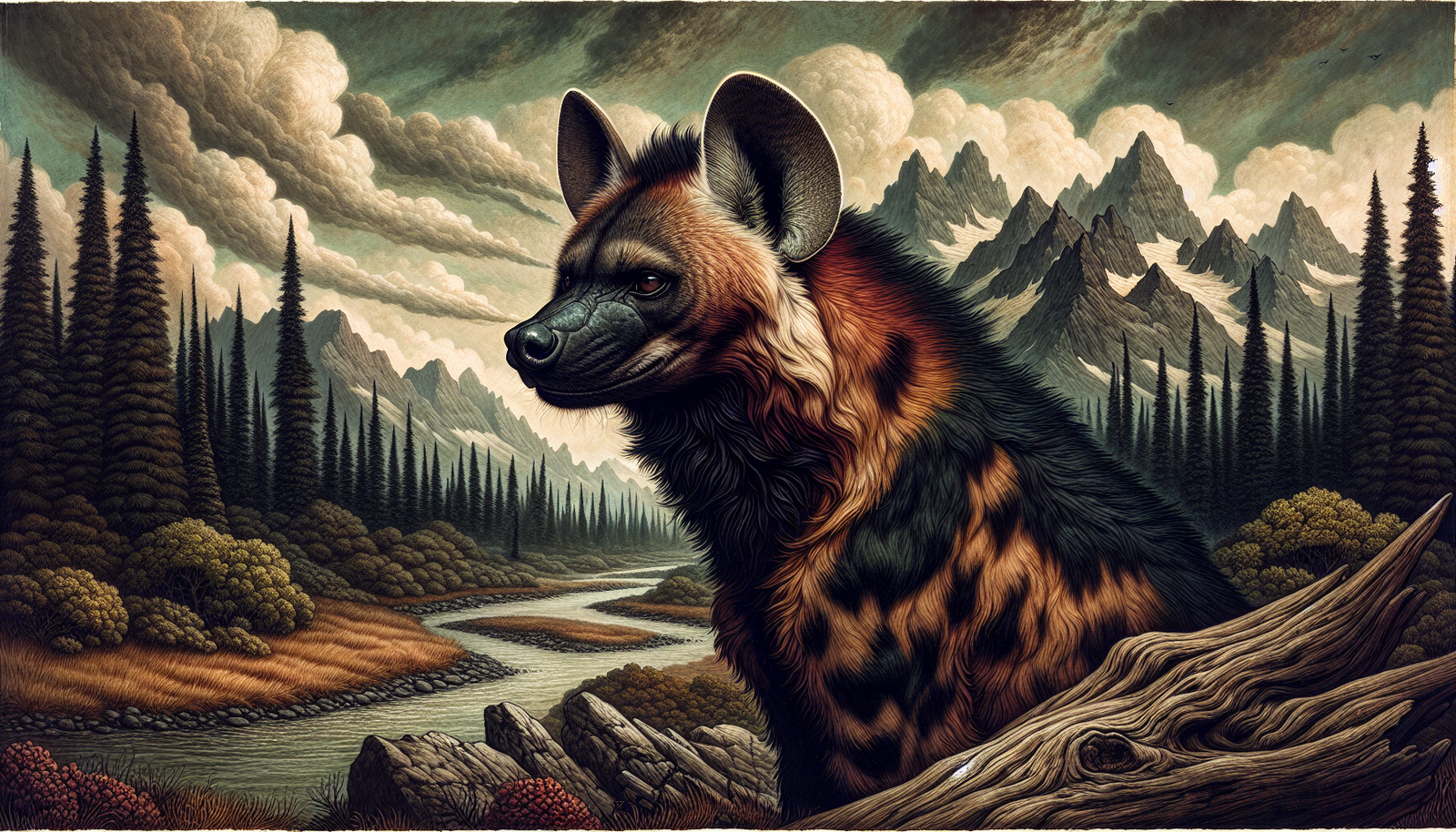Mystery of the American Hyena

By James Roberts, Cryptozoologist
The American West is a land of legends and mysteries, a place where the lines between reality and folklore often blur. Among the many enigmatic creatures said to roam these vast expanses is the American hyena, a beast that has captured the imagination of Native Americans and pioneers alike. This elusive creature, while unconfirmed by modern science, has a rich history that hints at its possible existence, leaving us to wonder if there might be more to this legend than meets the eye.
As a cryptozoologist and researcher, I've long been fascinated by the tales of the American hyena. The consistency of the accounts, spanning centuries and cultures, suggests that there may be a kernel of truth hidden within the mythology. In this article, we'll delve into the mystery of the American hyena, examining the evidence, exploring the theories, and attempting to unravel the secrets of this enigmatic beast.
The Ioway Tradition and the "Shunka Warak'in"
One of the earliest and most compelling accounts of the American hyena comes from the Ioway people, a Native American tribe that once inhabited the Great Plains region. In their folklore, they speak of a creature known as the "shunka warak'in," a name that translates to "something that carries off dogs." This name alone provides a tantalizing clue about the nature of the beast, hinting at its predatory behavior and its reputation as a fearsome hunter.
According to Ioway tradition, the shunka warak'in was a large, hyena-like creature with a sloping back and dark fur. Its appearance was said to be reminiscent of the hyenas of Africa and Asia, with a powerful build and a distinctive gait. But perhaps the most intriguing aspect of the shunka warak'in was its cry, which was described as resembling human laughter. This eerie vocalization added to the creature's mystique and fueled speculation about its true nature.
The Ioway were not alone in their accounts of the shunka warak'in. Other Plains Indian tribes, such as the Lakota and Cheyenne, had similar legends of a hyena-like creature that stalked the prairies. The widespread nature of these accounts suggests that the shunka warak'in was not merely a localized legend, but a creature that was known and feared across the region.
One of the most intriguing pieces of evidence for the existence of the shunka warak'in comes from the early 20th century field notes of anthropologist Alanson B. Skinner. In his notes, Skinner mentions a "hyena skin" artifact that was allegedly taken from a shunka warak'in and worn as a shoulder amulet by the Ioway. While the current whereabouts of this artifact are unknown, its mention in Skinner's notes suggests that the Ioway may have had a physical specimen of the creature at one point, lending credence to their folklore.
Early Settler Accounts and the Ringdocus Specimen
As European settlers began to push westward in the 19th century, they too encountered strange and unfamiliar creatures in the American wilderness. One of the most remarkable accounts comes from Idaho's Boise National Forest in 1909, where a group of hunters shot what they described as a "freak wolf." This creature was said to be much larger than a normal wolf, with a thick, black coat that set it apart from the typical gray wolves of the region.
The hunters were puzzled by the creature's appearance, and even the biologists who examined the specimen in Washington D.C. were at a loss to explain its unique features. This account, while anecdotal, suggests that there may have been a large, wolf-like creature roaming the forests of Idaho in the early 20th century, one that defied easy classification.
But perhaps the most tantalizing piece of evidence for the existence of the American hyena is the "ringdocus" specimen, a taxidermy mount that has become the stuff of legend among cryptozoologists. The story of the ringdocus begins in 1886, when a Montana rancher named Israel Hutchins shot a strange, hyena-like creature on his property. Hutchins described the animal as having a sloping back, dark fur, and a powerful build, all characteristics that match the descriptions of the shunka warak'in in Ioway folklore.
Hutchins took the carcass to a taxidermist named Joseph Sherwood, who mounted the specimen and displayed it in his Idaho museum. Sherwood labeled the creature as a "ringdocus," a "Rocky Mountain hyena," and even a "guyasticutus," a term that had previously been used to describe a mythical beast. The ringdocus specimen quickly became a local curiosity, drawing visitors from far and wide to gawk at the strange creature.
For decades, the whereabouts of the ringdocus specimen were unknown, and many assumed that it had been lost or destroyed. But in 2007, the mount was rediscovered in the collections of the Idaho Museum of Natural History, where it had been languishing in storage for years. The rediscovery of the ringdocus sparked a renewed interest in the American hyena, and researchers began to examine the specimen more closely.
However, the true identity of the ringdocus remains a mystery. Some experts believe that it is nothing more than a misidentified wolf or dog, perhaps a hybrid or a specimen with unusual physical characteristics. Others maintain that the ringdocus could be a genuine unknown species, a relict population of an extinct hyena or a creature that has yet to be described by science.
Unfortunately, without DNA testing or further analysis, the true nature of the ringdocus may never be known. The Idaho Museum of Natural History has been reluctant to allow invasive testing of the specimen, citing its historical and cultural significance. As a result, the ringdocus remains a tantalizing but frustratingly enigmatic piece of the American hyena puzzle.
Possible Connection to the Extinct "Running Hyena"
One of the most intriguing theories about the identity of the American hyena is that it could be a relict population of an extinct species known as the "running hyena" or Chasmaporthetes. This genus of hyena was once widespread across North America during the Pliocene and Pleistocene epochs, with fossils found from Alaska to Mexico.
Chasmaporthetes was a unique hyena, adapted for running and hunting in a way that sets it apart from its modern cousins. With a sloping back, a wolf-like build, and long, slender legs, Chasmaporthetes was built for speed and endurance, much like the modern cheetah. This adaptation allowed it to chase down prey across the open plains of ancient North America, making it a formidable predator.
The physical similarities between Chasmaporthetes and the descriptions of the American hyena are striking. Both creatures are described as having a sloping back, a powerful build, and a wolf-like appearance. The Ioway's shunka warak'in and the ringdocus specimen both match the physical characteristics of Chasmaporthetes, raising the tantalizing possibility that this extinct hyena may have survived into modern times.
If the American hyena is indeed a relict population of Chasmaporthetes, it would overturn much of what we know about the extinction timeline of this genus. The last known fossils of Chasmaporthetes date back to around 780,000 years ago, long before the arrival of humans in North America. If a population of these hyenas had survived into the modern era, it would suggest that they were much more resilient and adaptable than previously believed.
The implications of a surviving Chasmaporthetes population are profound. It would raise questions about the extinction patterns of other North American megafauna, and suggest that there may be other undocumented species still lurking in the wilderness. The discovery of a living Chasmaporthetes would be a landmark moment in zoology, reshaping our understanding of the continent's ecological history.
Of course, the idea of a surviving Chasmaporthetes population is still highly speculative, and much more evidence would be needed to confirm this hypothesis. But the tantalizing clues provided by folklore, historical accounts, and physical specimens keep this theory alive in the minds of many cryptozoologists and researchers.
Modern Sightings and Encounters
Despite the lack of definitive proof, sightings of the American hyena have continued into modern times. These encounters, while anecdotal, provide compelling evidence that there may be a large, hyena-like creature still roaming the wilds of North America.
One of the most remarkable modern sightings comes from the Hockomock Swamp in Massachusetts, where a police officer encountered a massive, hyena-like creature in 2016. The officer described the animal as being up to 7 feet tall when standing on its hind legs, with a powerful build and a distinctive, loping gait. This sighting is particularly noteworthy because of the witness's credibility as a trained observer and the level of detail provided in the account.
Another intriguing encounter occurred near the Alberta Wildlife Park in Canada in 1991. Several witnesses reported seeing a "hyena-lookalike beast" pacing back and forth along the park's perimeter. The creature was described as having heavy forequarters, low hindquarters, and a distinctive gait, all characteristics that match the descriptions of the American hyena.
In 2010, a couple in New York's Adirondack Park had a similar encounter, spotting a hyena-like animal chasing deer on two separate occasions. The witnesses described the creature as having a sloping back, a shaggy mane, and a brindle coat, features that are consistent with other sightings of the American hyena.
These modern encounters, while rare, suggest that the American hyena may be more widespread than previously believed. Many of these sightings occur near roads or human activity, indicating that the creature may be adapting to the encroachment of civilization into its habitat. The consistency of the descriptions across these encounters, despite the geographic distance between them, lends credence to the idea that there is a real, undocumented species behind the legend of the American hyena.
Alternative Theories and Explanations
Despite the compelling evidence for the existence of the American hyena, there are alternative theories and explanations that must be considered. One of the most common is the idea of mistaken identity, with skeptics suggesting that sightings of the creature may be nothing more than unusually large wolves or feral dogs.
It's true that some wolf or dog specimens can have dark fur and a distinctive gait, which could lead to misidentification by inexperienced observers. However, this theory fails to account for the consistency of the hyena-like descriptions across multiple sightings, and the fact that many witnesses are experienced outdoorsmen or trained professionals.
Another theory is that the American hyena could be an undiscovered species of bear-dog, or Amphicyonidae. This extinct family of carnivorous mammals shared many physical characteristics with hyenas, including a powerful build and a distinctive gait. While the idea of a surviving bear-dog species is intriguing, it is more speculative than the Chasmaporthetes hypothesis, with less fossil evidence to support it.
Finally, there are the more supernatural or cryptozoological explanations for the American hyena. Some researchers have suggested that the creature could be a surviving population of the Pleistocene cave hyena, Crocuta crocuta spelaea, or even a completely unknown species of hyena-like animal. While these ideas are entertained by some enthusiasts, they are highly speculative and lack any concrete evidence to support them.
The Enduring Mystery and Ongoing Research
Despite decades of sightings, stories, and speculation, the true identity of the American hyena remains a mystery. Without definitive proof, such as clear photographs, video footage, or physical remains, the creature's existence cannot be confirmed with certainty. The anecdotal evidence, while compelling, is not enough to sway the scientific community, which demands a higher standard of proof.
However, the lack of definitive evidence does not mean that the American hyena is a mere figment of the imagination. The consistency of the accounts, the physical evidence of the ringdocus specimen, and the tantalizing possibility of a surviving Chasmaporthetes population all suggest that there may be a real creature behind the legend.
The challenges of researching the American hyena are significant. Its elusive nature, its apparent rarity, and its possible adaptation to avoiding human contact all make it a difficult subject for study. But as technology advances, new opportunities for research are emerging. The use of camera traps, for example, has revolutionized the study of rare and cryptic species, allowing researchers to gather evidence without the need for direct observation.
Similarly, advances in DNA analysis and other molecular techniques could provide new insights into the identity of the American hyena. If physical evidence, such as hair or scat, could be collected and analyzed, it might be possible to determine the creature's true taxonomic identity and its relationship to known species.
Regardless of whether the American hyena is ever definitively identified, its legend will endure. The creature has captured the imagination of generations, from the Ioway storytellers to modern cryptozoologists, and its mystery continues to inspire wonder and curiosity about the natural world.
In many ways, the American hyena is a symbol of the untamed wilderness, a reminder that there are still secrets to be uncovered and mysteries to be solved. Its enduring presence in folklore and popular culture speaks to the human fascination with the unknown, and the desire to explore the boundaries of what is possible.
As a researcher and a lover of the wild, I am drawn to the mystery of the American hyena. The creature represents the thrill of discovery, the possibility that there are still wonders to be found in the world around us. Whether it is a surviving Chasmaporthetes, a misidentified wolf, or something else entirely, the American hyena is a reminder that the natural world still holds secrets and surprises for those who are willing to look.
In the end, the search for the American hyena is about more than just solving a cryptozoological puzzle. It is about the human relationship with the wild, the desire to understand and connect with the creatures that share our planet. By pursuing the mystery of the American hyena, we are not only seeking to unravel a biological enigma, but also to deepen our appreciation for the complexity and wonder of the natural world.
As we continue to explore the legend of the American hyena, we must approach the subject with a mix of skepticism and open-mindedness. We must be willing to follow the evidence wherever it leads, while also recognizing the limitations of anecdotal accounts and the need for rigorous scientific inquiry.
But we must also keep alive the sense of wonder and curiosity that drives us to seek out the mysteries of the world around us. The American hyena may prove to be a biological reality, a cultural artifact, or something in between, but the search for the truth is a worthy endeavor in itself.
In the end, the legend of the American hyena is a testament to the enduring power of mystery, the allure of the unknown, and the human desire to explore the boundaries of the possible. Whether we ever unravel its secrets or not, the creature will continue to captivate the imagination, inspiring new generations of researchers, storytellers, and adventurers to pursue the mysteries of the wild.
From Bigfoot to UFOs: Hangar 1 Publishing Has You Covered!
Explore Untold Stories: Venture into the world of UFOs, cryptids, Bigfoot, and beyond. Every story is a journey into the extraordinary.
Immersive Book Technology: Experience real videos, sights, and sounds within our books. Its not just reading; its an adventure.



























